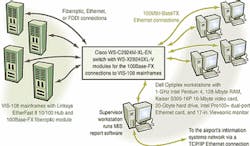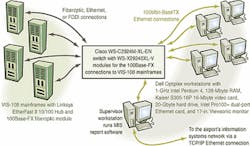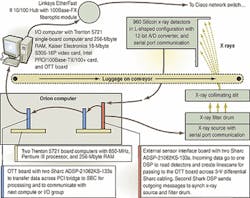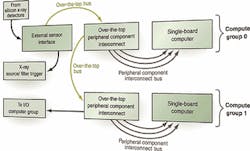Baggage imaging detects contraband
Distributed computing equipment integrated into an x-ray baggage-handling system examines suitcases for bombs, drugs, and contraband.
By R. Winn Hardin,Contributing Editor
In the wake of the terrorism attacks last Sept. 11, airport security has entered the forefront of US consciousness. But even today, fewer than five of 100 traveling bags checked in by passengers at US airports are scanned for explosives and other dangerous weapons and objects. That number could reach 100% by 2003 based on a bill under consideration by the US Congress. Although the bill has been delayed by political wrangling, it could be approved when politicians realize that not all airport terminals are created equal in the United States.
International airport terminals in the United States must meet European requirements that 100% of baggage be inspected for bombs and other dangerous devices. This was the problem that architects faced when designing a new international terminal in New York City—how to inspect millions of pieces of luggage each year without hiring a small army of workers.
Inspection networkUS airport designers have to structure terminals that deal with substantially higher numbers of passengers compared to their European counterparts. An analysis conducted by the airport architects in New York City (the airport name is being withheld in the wake of recent events) determined that PerkinElmer (Woburn, MA) offered a fast, commonly used automated baggage-inspection system in Europe—the VIS system. A cost analysis against human inspectors and more-accurate but higher-priced and significantly slower three-dimensional (3-D) computed-tomography (CT) inspection systems determined that the VIS-108 inspection system would pay for itself in reduced acquisition and maintenance costs within 1.5 years.Part of the high-throughput and cost savings associated with the VIS system comes from PerkinElmer's redesign of the processing architecture. The new design implemented in 1999 used a VME-based system with Skybolt image-processing boards from Sky Computers (Chelmsford, MA). The redesigned system is a PCI-bus-based distributed-computing model that uses a combination of proprietary boards armed with Analog Devices (Norwood, MA) Sharc digital-signal processors (DSPs) and pairs of off-the-shelf single-board computers (SBCs) to distribute computational loads and improve inspection speeds.
The VIS-108 mainframe system uses noncontact-scanning baggage inspection to detect explosives, drugs, and other contraband materials at rates to 1800 bags per hour, or one bag every two seconds. It satisfies Federal Aviation Administration (FAA) certified detection levels but at false-alarm rates higher than specified US requirements. Computed-tomography systems generally produce fewer false alarms but typically can inspect only 100 to 200 bags per hour. After a suspicious bag is identified, the VIS-108 mainframe sends an image of this bag to a review workstation via a fiber distributed-data interface (FDDI) connection for review by a human inspector.
FIGURE 1. PerkinElmer installed four VIS mainframes at a new international terminal in a New York City airport recently, as well as an additional four review workstations and a supervisory workstation. The mainframes are connected to a Cisco switch via fiber distributed-data interface connections and from the switch to the workstations via 100Base-T Ethernet connections. If the workstation data agree with those of the automated systems that a baggage scan shows contraband material, the inspection system automatically informs the Baggage Control System to route the bag to a human inspector.
Although the VIS-108 mainframe does communicate with the airport's main computer network via a supervisory workstation using special software, the inspection network design deals less with information system infrastructure and more with the mechanical conveyor systems that deliver baggage from the airport check-in counters to the airplane. According to New York project manager at PerkinElmer and vice president of product and business development Michael Ellenbogen, the company determined that the airport terminal would require four VIS systems, supported by four level-2 workstations and one supervisory workstation (see Fig. 1).
FIGURE 2. PerkinElmer inspection system scans baggage with two distinct x-ray energies to determine the atomic number of dangerous objects within a bag. A rotating drum of brass and lexan filters synched to the x-ray pulses helps guarantee that only high (150 keV) or low (75 keV) energy makes it to the bag at any given time. The time between the 2-ms pulses is used to remove dark current from the 960 silicon x-ray detectors and, therefore, reduce noise from the resulting scanned image.
The process begins with the Baggage Control System, which essentially delivers a bag to the VIS mainframe and then later moves the bag to the airplane (see Fig. 2). A proprietary External Sensor Interface (ESI) PCI board with two Analog Devices 40-MHz floating-point ADSP-21062KS-133 DSPs mounted in plastic quad flat packs starts the inspection process. The first DSP triggers the PerkinElmer proprietary dual-energy x-ray source at the bottom of the mainframe through a proprietary connection. The source pulses every 2 ms, initially at 75 keV and then at 150 keV.
Each x-ray pulse travels through a rotating filter drum that is also synched by the first DSP on the ESI board. Bands of lexan and brass filters are mounted on this drum directly above the x-ray source. The lexan filter is in the beam when the x-ray output is 75 keV. The brass unit filters lower-energy components of the x-ray spectrum when the 150-keV pulse is emitted. All x-ray pulses are collimated through a lead slit. The x-ray energy is then spread into a fan shape as it enters the baggage containment area from one side of the bottom of the conveyor. Placing 960 silicon x-ray detectors above the baggage and along the side of the baggage that is opposite to the x-ray source helped to reduce the size of the inspection system. "Real estate becomes an issue behind the counter at airports," explains Ellenbogen.
The second DSP on the ESI board receives 12-bit digital data from each of the 960 detectors via a serial port connection on the ESI board's host—a Trenton Technologies (Gainesville, GA) CB-basic 5721 SBC containing an 850-MHz Pentium III microprocessor and 256 Mbytes of RAM. Vivid Technologies designed the detectors and internal A/D converter along with the x-ray source prior to PerkinElmer's acquisition of Vivid in January 2000. The detector data are collected by the second DSP in local memory. Once a complete line of 960 values is collected, the information is sent across a hardwired connection from the DSP on the ESI board to a proprietary "over-the-top" (OTT) board. This board is named for its ability to facilitate fast direct memory access (DMA) data transfers from the sensor interface board to the SBC for processing or to the OTT board connected to Compute Group 1 in the event that Compute Group 0 is still busy processing the previous bag (see Fig 3).
The two OTT boards collect line data until the entire bag has been scanned. They then store the x-ray detector data in 126 Mbytes of on-board memory. Proprietary algorithms running on the SBC in either a Windows NT 4.0 or Linux operating environment compare the low-energy x-ray data, produced by Compton scattering, against the high-energy data, caused by the photoelectric effects of the x-rays interacting with the baggage. The comparison of the x-rays at these two energy levels determines a Z factor, or atomic number, of all materials along the optical axis of each pixel.
The system software then uses another proprietary edge-detection algorithm to separate overlapping objects, a bar of soap from a handgun, for instance. Next, the system determines the Z factor for individual objects based on a combination of object edge detection algorithms and the cumulative effect of overlapping objects on the Z factor value. By separating each object and determining its probable atomic number and comparing that number with a look-up table of atomic numbers for organic and inorganic materials, the VIS-108 mainframe decides whether a bag potentially houses a handgun or just a bar of soap.
According to PerkinElmer Detection Systems engineer John Reilly, getting the baggage-inspection-system throughput to 1800 bags per hour while conducting the complicated processing required by the system was a computational burden for the older VME-based system. "We were using a Radisys (Hillsboro, OR) control PC to do the data handling, a number of proprietary boards for system interfaces, and Skybolt boards for number crunching, but it was all expensive and performance limited. It was a 10-year-old design, and we had used the existing technology at the time," Reilly says.
Backup needsAfter each bag is inspected, the results are communicated from the OTT board in compute group 1 to the final I/O compute group. This Trenton SBC-based machine also has an OTT board, a Kaiser Electronics (San Jose, CA) S305-16B (16-Mbyte) video card, to display the results on an embedded LCD screen on the VIS side panel, and an Intel (Santa Clara, CA) Pro/100Base-TX/100+ Ethernet card. Processed images use false-color techniques to identify suspicious objects. Pass/fail data are sent through an Ethernet card to a pair of Linksys (Irvine, CA) 100Base-FX fiberoptic media converter modules. Most VIS systems utilize dual Ethernet ports to improve the network's resilience.In the New York City airport-terminal installation, the Ethernet signal is converted to a FDDI signal for transmission to the inspection system network's main switch, a Cisco (San Jose, CA) WS-C2924M-XL-EN with WS-X29240XL-V modules for the 100Base-FX signals from the VIS mainframes. The standard option is fiberoptic-based Ethernet rather than FDDI, Reilly says, although the system can be configured for Ethernet as well. The fiberoptic conversion is necessary in most instances because the inspection systems are located a far distance from the switch, which is typically located in the same room as the review workstations. Moreover, an Ethernet network does not possess the low-noise immunity and long-transmission range that a fiberoptic cable does.
If a bag contains suspicious material, its image is transmitted to one of four workstations for review by a human inspector. Pass/fail data and bag identification information are also sent to the supervisory workstation running PerkinElmer's MIS Bridge software. Like the review workstations, the supervisory workstation contains a Dell (Round Rock, TX) Optiplex computer with 1-GHz Pentium IV microprocessors, 128 Mbytes of RAM, a Kaiser S305-16P video card, an Intel Pro 100-plus Ethernet card, a Viewsonic (Walnut, CA) Optiquest Q75 monitor, and a generic IDE 20-Gbyte hard drive.
The supervisory workstation is also assigned a TCP/IP address on the airport terminal's main computer network so that it can send report data as requested to the main network. An important difference between the review and supervisory workstations is the keyboard. The review workstations use an industrial touchscreen pad from 3M Touch Systems (Methuen, MA). While the machine is looking for the explosive materials, the operator's job is to review the image of a suspect bag and look for other objects that would be needed to support a complete explosive device. These objects might include a detonator, wires, a timing device, and a power supply. Image-manipulation techniques like zoom and contrast adjust are often needed to see these details. The touchpad is an intuitive means for a security operator to invoke the imaging functions needed to review the x-ray image.
With this recent upgrade in computing power for the VIS mainframes, Ellenbogen says that most system changes come through periodic software improvements. Future automated baggage inspection development work at PerkinElmer is focused on improving the performance of the existing single view and its Argus CT-based inspection systems, which the company intends to submit for FAA certification this year. In addition, a new system that uses three x-ray sources to produce 3-D CT-like images with higher throughput than rotating head systems from InVision (Newark, CA) and L3 Communications (New York, NY) is in development.
Trials of the new PerkinElmer Multi-View Tomography system have produced certified levels of bomb detection with false-alarm rates that are higher than the FAA certification standard, but engineers continue to improve the system's algorithms and plan on delivering a new line of inspection systems throughout this year.
Company InformationAnalog DevicesNorwood, MA 02062www.analog.comCisco Corp.San Jose, CA 95134www.cisco.comDell Computer Corp.Round Rock, TX 78682www.dell.comIntel Corp.San Jose, CA 95052www.intel.comInVision TechnologiesNewark, CA 94560www.invision-tech.comKaiser ElectronicsSan Jose, CA 95134www.kaiserelectronics.comL-3 Communications Corp.New York, NY 10016www.L-3Com.comLinksysIrvine, CA 92614www.linksys.comPerkinElmer InstrumentsWoburn, MA 01801www.perkinelmer.comRadisys Corp.Hillsboro, OR 97124www.radisys.comSky ComputersChelmsford, MA 01824www.skycomputers.com3M Touch SystemsMethuen, MA 01844www.microtouch.comTrenton TechnologiesGainesville, GA 30504www.trentonprocessors.comViewsonic Corp.Walnut, CA 91789www.viewsonic.com


